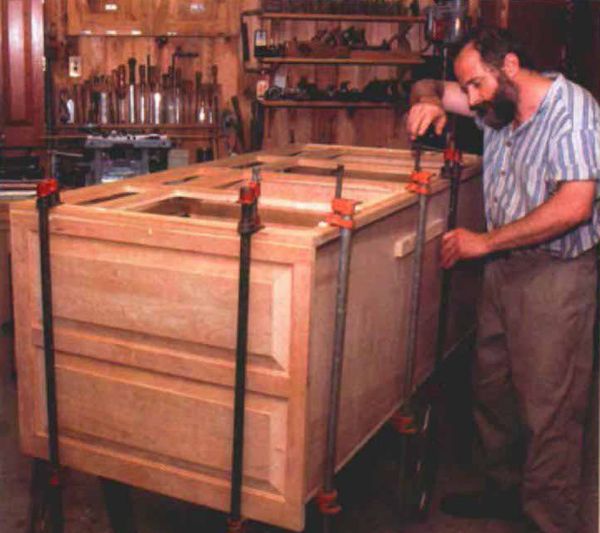Dressing Up Plywood Cabinets with Face Frames
Frames hide raw edges and provide a solid foundation for drawers and doors
Synopsis: How a face frame is made is no more important than how it’s designed, writes Joseph Beals, who has had his share of building difficult and easier ones. They should be designed like doors, he says, and he offers guidelines for designing them and assembling them. A detailed drawing shows their parts, and three assembly methods are illustrated. There’s information on attaching them to cabinets, both at the job site and in your shop. A series of photos illustrates his method of making face frames, and a side explanation presents options for joining frames at a cabinet corner.
One of the first face frames I built was a nightmare at every step. It was a maple behemoth, more than 11 ft. long, for a row of cabinets I had built at the job site. When I glued up the frame in my shop, the dowel joints would not line up until I fairly beat them together. I applied the finished frame on-site just as a thunderstorm blew in. I spread white glue on the back of the frame and used two hands, two knees and my forehead to hold it in place. A lightning bolt took out the power at about the third nail. As I set the frame by kerosene lamp, I decided face frames must be the nastiest job invented.
I have made plenty of face frames since then, and they don’t seem nearly as difficult anymore. I now make them with mortise-and-tenon joints and attach them to carcases with biscuits or with counterbored and plugged screws.
How a face frame is made is no more important than how it’s designed. Face frames should be a subtle element in the composition of a cabinet. A face frame that draws attention to itself through awkward pro- portions or wild grain isn’t doing its job.
And no matter how face frames are made, they all do the same thing. A solidwood face frame provides a finished front on casework that’s usually made of some manufactured material such as plywood or fiberboard. The frame covers the raw edges, provides a place to hang doors, fit drawers and attach trim. Face frames are appropriate for a variety of practical, builtin and free-standing furniture.
Design face frames like doors
Parts of a face frame are best put together as if they were a conventional door frame: Outer stiles should run full height, with top and bottom rails let in between. Internal partitions should follow the same pattern.
From Fine Woodworking #128
For the full article, download the PDF below:
Fine Woodworking Recommended Products

AnchorSeal Log and Lumber End-Grain Sealer

Blum Drawer Front Adjuster Marking Template






















Log in or create an account to post a comment.
Sign up Log in